The glorious Persian heritage can be experienced through a wide range of clothes belonging to different cities and cultures of Iran. Clothing has always been one of the most dominant issues since the ancient years in Iran. Traditional Iranian clothing can show you how different people from different tribes with their critically different lifestyles and cultures introduce themselves as Iranian and belong to a unified country. Many factors caused this phenomenon to occur; the geographical situation, their religious beliefs, social conditions, and particularly the originality and nationality to which they belong, and thousand years ago were unified by Cyrus the Great and made into a multi-cultural country known as Iran.

Bakhtiari
The clothes of the Bakhtiari nomadic tribe are versatile by design and evolved to adapt to the extreme weather conditions they may encounter during migration – from the grassy plateau of the Khuzestan region to the mountainous Chahar Mahal. Bakhtiari women are often seen wearing colorful, layered skirts paired with matching vests. Women’s long headscarves are decorated with hand-stitched ornaments. The men wear tunics, wide trousers fastened at the ankle, and woolen hats, and they use chugha (a kind of male topcoat).

Qashqai
The Qashqai nomadic tribe has members of Turkic, Kurdish, and Arabic origins. Women wear layered colorful skirts and long headscarves pinned under the chin. Their men on the other hand wear colorless white shirts and long cloaks, secured around the middle by a cummerbund. The round dogushi hats which are made of sheep’s wool felt are a trademark of this tribe.
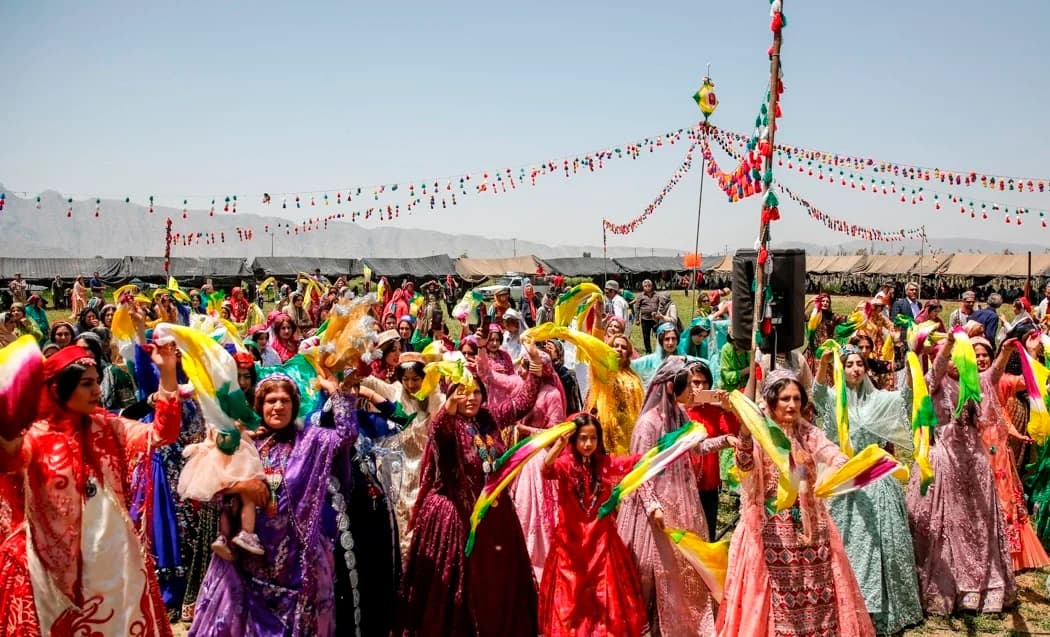
Lur
Lur men tend to favor neutral colors, black felt hats, and white shaals wrapped around their waists. Women have bright-colored clothing, with trademark stripes hemmed on the cuffs of their trousers. Also, the headscarf (which has coins and beads dangling) is wrapped around the head, neck, and shoulders, and a long piece of it hangs down the back. The amount of detail that goes into the lur traditional clothing makes it one of the most eye-catching.

Baluch
With a history dating back to more than 5000 B.C., the Balooch is one of the oldest tribes in Iran. It’s no wonder they own one of the best ancient cultures and traditional clothing in Iran. The Baluch traditional clothing still follows the style dating back a thousand years with only a few changes. The most important thing to keep in mind about the Baluch women’s clothing is being colorful. Which brings many photographers to the region to take their pictures. Baluch women wear gold bracelets, necklaces, and brooches. For men, it’s customary to wear long pants, loose-fitting shirts, and a turban.

Turkmen
For hundreds of years, the Turkmen tribe has lived nomadic lives. With many now rooted, by living in permanent homes and tents, some still continue the nomadic tradition. Wearing long dresses with open robes, women often conceal part of their face with a cloth hanging just below the nose. Also, wool hats, are a prominent feature of men’s clothing which protects them against cold weather. Some live in the Khorasan Razavi Province.
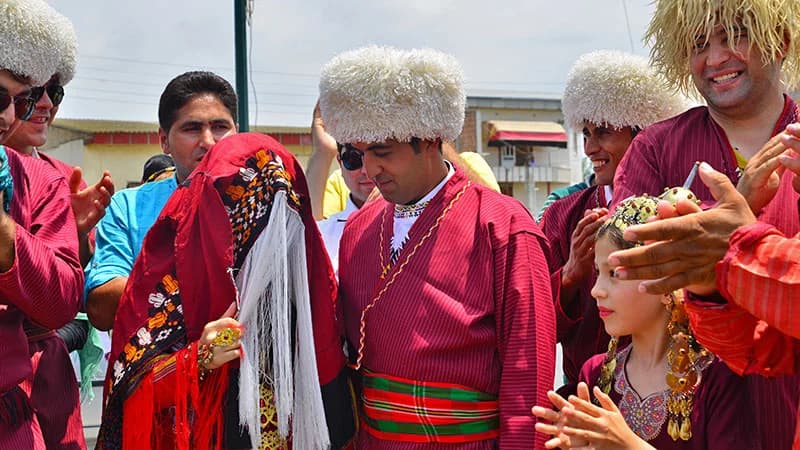
Kurds
The native Kurdistan tribe’s traditional dress varies slightly from region to region since the vast territory spans parts of Turkey, Syria, Iraq, and Iran. Both men and women wear baggy clothes shaped at the waist by a wide belt. As women decorate their headscarves with dangling coins and jewels, men wear matching jackets. The older women of the tribe tend to put on dark clothes in comparison to the younger ones.
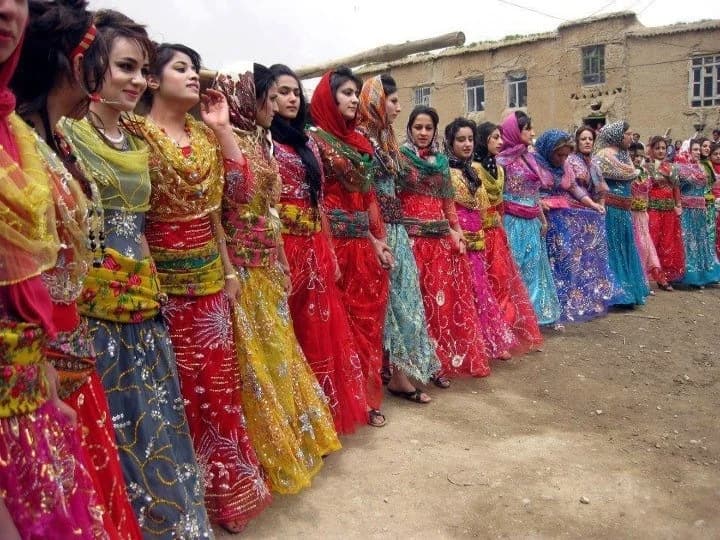
Abyaneh
Abyaneh village in central Iran is one of the oldest places in the country. The elders of this village have kept traditions alive by continuing to dress traditionally. Women wear layered skirts over black trousers, while their signature long, white floral scarves cover their hair and shoulders. Men’s traditional clothing consists of wide-legged black trousers, colorful vests, and wool skullcaps.
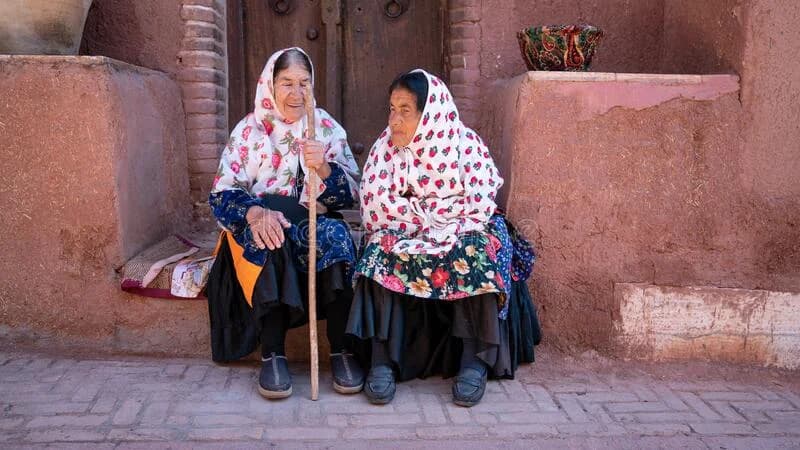
Gilak
The Gilak is native to the northern region of Gilan. Unlike the other tribes of Iran, these are not nomads andtend to farm and raise livestock in the Alborz mountain range and surrounding plains. Gilak women wear long pleated shirts layered with black velvet vests trimmed with bright embroidery. They also wear floor-sweeping long skirts decorated with colorful horizontal stripes. Men tend to wear black & white themes punctuated by a bright splash of color in the socks or wide cotton waistband.
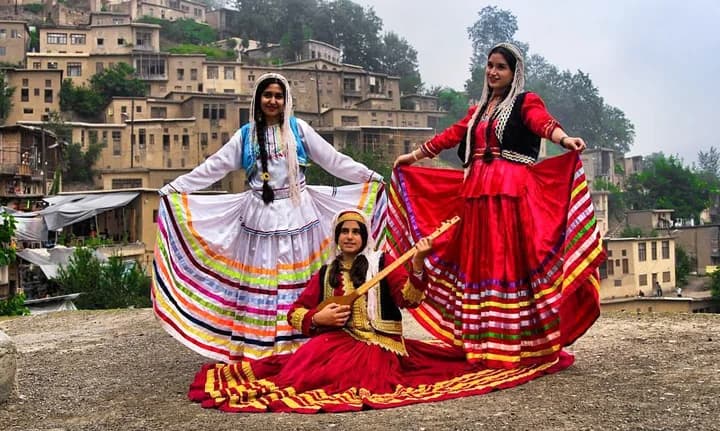
Hormozgan
The Hormozgan women's cloth has different variants such as Kandureh, Gavan, Oshkom, Noshteh, wrinkle, Ajam, Arabic, and plain. The amazing style of the southern traditional clothing of Iran protects the body from extreme sunlight and the hot weather. Using very soft and thin cloth for the dress, they are combined with pants which are decorated by needling showing their passion and talents. One of the most notable clothing of Qeshm is their brightly colored, floral chadors and niqab (face covering). There are 2 types of niqab, one gives the impression of thick eyebrows and a mustache from afar (a ruse used in the past to fool potential invaders into mistaking women for men), and the other is a rectangular embroidered covering revealing only the eyes. Although they are part of a centuries-old tradition that helped protect the face from the wind, sand, and scorching sun, many women choose not to wear the niqab nowadays.

Conclusion
In conclusion, Iran’s traditional clothing is a rich tapestry of the country’s diverse ethnic groups and their unique customs. From the Bakhtiari’s versatile attire designed for extreme weather conditions, to the Baluch people’s voluminous shalwar kameez, and the Turkmen’s earthy tones, each tribe’s traditional dress tells a story of their heritage and lifestyle. The Kurds’ baggy clothes shaped at the waist by a wide belt are another example of the diversity in Iranian attire. These traditional clothes, often embellished with intricate patterns, embroidery, and beadwork, not only serve a functional purpose but also showcase the artistic abilities of Iranian artisans. Despite modern influences and changes in fashion trends, these traditional outfits remain a significant part of Iran’s cultural identity. They are a testament to the country’s rich history and the resilience of its people in preserving their traditions.